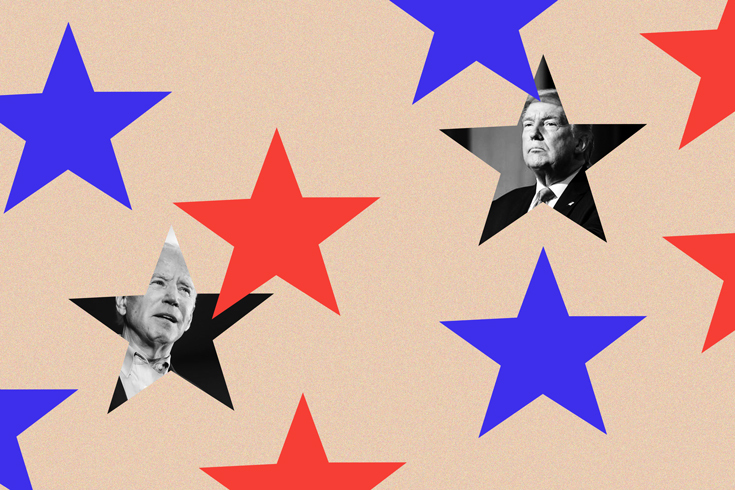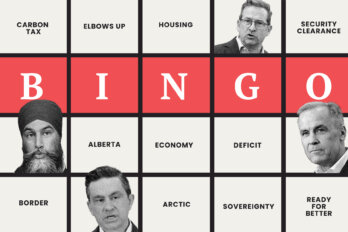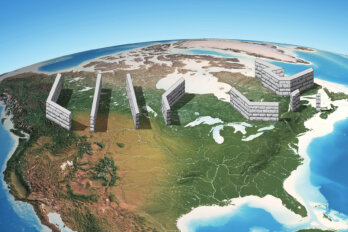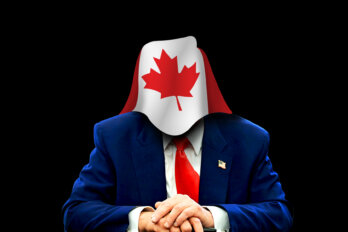In 1930, the US military finalized War Plan Red, which laid out what would happen were America to find itself at war with the United Kingdom. Canada was still under British dominion at the time, and the plan, updated as recently as 1935, mapped out an invasion of its northern neighbour. The plan recommended that America steam into major cities like Halifax, Montreal, and Toronto in order to ensure the quick collapse of Canada—code name Crimson. “Crimson cannot successfully defend her territory against the United States,” the 1935 war plan concluded.
Canadians shouldn’t feel too precious: America had colour-coded war plans for plenty of foreign nations. Tan was Cuba, orange was Japan, indigo was Iceland, and so on. Americans, ever-adept military planners, had contingency plans for everything. From “stimulating Azores independence,” in case Portugal fell amid unrest in the 1970s, to extensive nuclear war plans in case of a Soviet strike.
“The word ‘if’ is the big operator in contingency planning,” a military officer told the New York Times in 1984. “If these guys do this, then we will do that. And you have to have more than one option, including the worst case.” (A Pentagon staffer told the Times that “we have plans around here for everything” but, when asked about plans regarding a possible Canadian invasion, offered: “Well, not quite that.”)
Election day has come and gone in America, the conclusion of four years of tension and tumult and the coda to one of the most miserable and gruelling US presidential campaigns in modern memory. As the projections trickled in, and the results showed an anxiety-inducing neck-and-neck race, Trump took to the stage at a 2:30 a.m. press conference, from the White House, to allege that the Democrats were trying to “disenfranchise” voters—by counting all the votes. It had all the hallmarks of a man trying desperately to cling to power. Even as Tuesday night stretched into Wednesday morning, the results in Pennsylvania, Nevada, Georgia, and North Carolina remained too close to call. Wisconsin looks set to go to a recount.
Officials in government, from Global Affairs Canada to the Canadian Security Intelligence Service, should have been—and likely were—running through every possible scenario, no matter how dire or unlikely. Even as the electoral map points to an increasingly probable Biden victory, a situation in flux means anything is possible. As Canadians, we haven’t often had the occasion to confront America’s democratic deficits or its institutional shortcomings. They were punchlines or academic concerns, but now they are very much out in the open.
Contingency planning is an art. It means drawing up a list of predictions that go well beyond who will win and who won’t. It requires the government to envision civil unrest, court battles, constitutional crises, and international chaos. Indeed, there are few times when such contingency plans have been more necessary.
The last four years have tested the American system, and it is creaking under the weight. If the dam breaks, it’s Canada that gets wet. What then?
Consider the state of play:
From the White House, the president has been deeply skeptical of the rule of law. He has been a cheerleader for police abuse. He has encouraged the death penalty for drug dealers and praised foreign leaders who employ extrajudicial killings. He has celebrated, and even ordered, aggressive and militarized crackdowns by local, state, and federal police on largely peaceful demonstrations. He has vilified Black Lives Matter and antifascist protesters, who have organized to protest the indefensible killing of unarmed Americans.
In private chat rooms and on rural compounds, the militia movement, often driven by far-right, white supremacist, and neo-Nazi extremism, has shown a willingness to deploy violence—even regime change—to advance its goals of some ideologically or racially pure state. These movements are known to have infiltrated the American military despite the Pentagon’s best efforts to root them out. In October, six people were charged for orchestrating an actual coup in Michigan. They may well have succeeded in kidnapping the governor had they moved quicker. (Trump, meanwhile, has equivocated on whether the plan to overthrow the state government was, in fact, bad.)
Then there’s QAnon, the cultish movement that has been described as a conspiracy theory or a collective delusion. Its followers genuinely believe that Donald Trump is a crusader for good, pushing back against a Satanist deep state responsible for the mass abduction, imprisonment, and murder of children. They have taken to heart the president’s insistence that any result that does not return him to power is thanks to a devious fraud carried out on the American people.
Next up is COVID-19 “trutherism.” Deeply skeptical of scientific realities, adherents insist that lockdowns, mask orders, and the possibility of mandatory vaccinations are an infringement on their personal freedoms. Until now, they have had a man in the White House who has, at least in some respects, spoken their language. But, if the American government has to take more drastic measures to contain the spread of the virus, protests will likely ensue.
To date, problems presented by these realities have been manageable. Trump has not tried to deploy federal police or the national guard to serve his own ends—at least, not since June. The militia movement has been under close scrutiny, both from police and from nongovernmental watchdogs. Black Lives Matter and Antifa have continued to press for wholesale reform, not violent revolution. While individual QAnon adherents have shown a penchant for violence, there is no evidence thus far that the wider movement is an imminent threat, except maybe to our collective discourse. And the COVID-19 truthers have limited themselves to street protests and quixotic displays of supposed individual liberty. The resulting harm has been largely indirect rather than violent, apart from torching the occasional cellphone tower.
But contingency planning is the art of considering extreme scenarios. And things are already fairly extreme. As of right now, we have two men, both insisting on a claim to the White House.
History is littered with schisms that formed from competing claims to power. The Roman Catholic Church probably never anticipated having to face antipopes, but the period from 1309 to 1417 offers a cautionary tale of what can happen when, thanks to internecine power struggles stemming from frustration over an elected figure, there emerge rival claimants to a throne. America, of course, has very little in common with a medieval religious institution, but it wouldn’t hurt to remember that the Church spent decades in crisis watching competing pontiffs argue about who had authority over itself.
The rival claims to power in the presidential election stem from real and perceived problems with the conduct of the election itself. Even before voters went to the polls, nefarious tricks—closed polling locations, burned ballot boxes, and voter suppression—conspired to tip the scales in the Republicans’ favour. Now that the votes have arrived and several states hang in the balance of mail-in ballots, there are a litany of dirty tricks that could be pulled out to disqualify those early votes, which disproportionately hurts the Democrats. Trump has already said, fairly bluntly, that the counting should stop in certain battleground states, and that he will go to the Supreme Court to get his way.
The courts’ role in safeguarding democracy is an open question. There is a credible and compelling case that court intervention, at many levels, in the 2000 Florida recount illegitimately put George W. Bush in the White House. It’s only gotten worse since then. A six-to-three conservative majority on the Supreme Court, and a recent trend toward nonintervention in contentious voting-rights cases, leaves it very much in doubt that the courts could beat back nefarious efforts to disqualify voters or throw out votes as the counting continues.
Then there’s the wonkery of the system itself and the possibility of “faithless electors,” or actual members of the electoral college who opt to vote differently than their state’s wishes. In 2016, Bernie Sanders, John Kasich, Faith Spotted Eagle, and Colin Powell all technically won electoral college votes because the electors themselves were aghast at the way their states had voted and opted for an alternative candidate. A handful of faithless electors could, in theory, change the results of an election.
And, finally, there’s Capitol Hill. There are some series of events that could lead to a tie vote—which would need to be decided by Congress. There is all sorts of procedural chicanery that could be used on that front. The Democrats, even if they hold the lower house, have regularly found themselves on the losing side of conflicts due to a pathological insistence to play by the rules.
Any president who tries to take power, armed with a ruling from a stacked court or a mandate from a floor vote, will have a legitimacy problem. But seemingly illegitimate power is still power, if you can hold on. Trump may convince himself he has good reason to dispatch law enforcement into the streets, to quell protests that may arise from a contested result. Even if Black Lives Matter and Antifa have legitimate grievances with a president looking to consolidate power, they may prove a useful foil for Trump. Other supporters could mobilize themselves. Militias are already describing these results as a “coup” and have the means and motivation to take to the streets. Even if a winner is declared, there is sure to be a sizeable chunk of the population that will refuse to accept the results and may see it as their duty to fight back.
So, for Canada, what do we do in a scenario of prolonged US turmoil? Five years ago, in fact, Ottawa sought some help to anticipate what would happen in the event that the country was under threat. It asked a security contractor to assess the vulnerability of critical infrastructure in light of possible terror attacks or insurrection. Of course, these checks were precautions—it’s better to be safe, as they say, than sorry—but that 2015 assessment had little to do with what we’re currently facing: uncertain results, a defiant incumbent, a tense and fractious security situation.
What happens if America can’t form a government? Congress, after all, has only funded operations until December. America has had shutdowns before, but there’s no telling what happens if there’s no government in office to end them. A protracted and widespread government shutdown could hobble trade or the movement of critical goods necessary for Canadian supply chains. Our continental air-defence systems rely on American radars and jets. International security largely relies on American troops stationed abroad to dissuade expansionary foreign powers like Russia. Violence and strife could propel a wave of immigration across the border—both those who hoped for refuge in America and Americans fleeing the chaos.
These are all medium-term problems. As we know from failed states worldwide, once democracy snaps, it can take a long time to repair. What does it mean for Canada to live next to a broken system for the foreseeable future? What does that mean for our economy, our media, our society? Nothing good.
The most likely scenario is that all the bad things I’ve described do not happen. The most probable scenario is that votes don’t get trashed en masse, the courts ensure every vote gets counted, Congress doesn’t have to pick a president, and both sides accept the results. Even if the process does go awry, the odds are good that American democracy stays resilient and the courts do their job credibly. At the very least, even if all the systems break and norms crumble, we can almost certainly count on the vast majority of Americans staying level-headed and gritting their teeth to make whatever fractured result work.
America is one of the most robust and complicated democracies in the world. It will take more than this to break it.
Hopefully.




